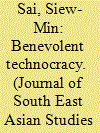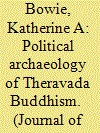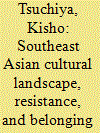|
|
|
Sort Order |
|
|
|
Items / Page
|
|
|
|
|
|
|
| Srl | Item |
| 1 |
ID:
181277


|
|
|
|
|
| Summary/Abstract |
The 2005 launch of a large-scale rubber plantation in Bachiang district, one of several in southern Laos, caused serious discontent among the local villagers whose traditional farming and foraging lands were seized and leased to a rubber company. This and other similar rubber developments based on land concessions in the south have drawn criticism from various quarters, including scholars and nongovernmental organisations. This study highlights how the locals’ views, livelihoods and lifestyles have been changing since the plantation was established, especially since rubber tapping began, and focuses on desires that may have directed their actions. Through an ethnographic approach tracing these changes over time, this study demonstrates that differentiation and diversification within the village have become increasingly apparent owing to both the recent shift to plantation work and other impacts and changes brought about by wider society.
|
|
|
|
|
|
|
|
|
|
|
|
|
|
|
|
| 2 |
ID:
181275


|
|
|
|
|
| Summary/Abstract |
The Chinese Protectorate was first established in Singapore in 1877 with the limited objective of preventing abuses in Chinese labour migration, but it evolved multiple functions dedicated to governing Chinese migrants and residents in colonised Malaya. The Protector possessed extensive statutory powers and he was regarded as the official authority on all matters ‘Chinese’. This was an important yet under-studied colonial institution in the history of Chinese migration and settlement in Singapore and Malaysia. This article narrates the history behind the establishment of the Protectorate in the 1870s when ‘racialised governmentality’ of the Chinese population was institutionalised in colonised Malaya. The article underscores the significance of imperial and local contexts of the Protectorate's creation, arguing that it was a product of flexible adaptation of empire-wide practices of ‘protecting’ and governing liberated slaves, indigenous peoples and subsequently, indentured Indian labourers ‘humanely’. It is notable, therefore, that there was a coeval and conjoined discussion of migration control of Chinese as well as Indian labour migrants in Malaya during this period, but this history is hidden from plain sight by popular approaches studying labour migration as components of ethnic diasporas migrating from a single point of origin.
|
|
|
|
|
|
|
|
|
|
|
|
|
|
|
|
| 3 |
ID:
181276


|
|
|
|
|
| Summary/Abstract |
Sheila Allan was just 17 years old when Japanese forces invaded Malaya in late 1941. British leaders surrendered at Singapore in 1942, subjecting hundreds of thousands of soldiers and civilians to Japanese internment for the duration of the war — including Allan. During that time, she became infatuated with the women's camp commandant, Dr Elinor Hopkins, whom she described as a ‘dream mother’. Her love and admiration blurred the lines between familial intimacy and sexual desire. Meanwhile, Allan was categorised as ‘Eurasian’ by both her Japanese captors and other European captives. She longed to be regarded as British and Australian, like her father. Nonetheless, white women condemned Eurasian women as sexually lax and immoral and questioned their right to be interned. As a result, Allan's desires for a white ‘dream mother’ reveal the fraught nature of racial, gender and sexual identities in wartime and under colonialism. These influenced not only her methods and strategies of coping during the war, but her hopes of finding love and intimacy when it was over. Her story reveals how fragile colonial categories and wartime violence fractured the destinies of colonial subjects, while love and devotion could be life-affirming.
|
|
|
|
|
|
|
|
|
|
|
|
|
|
|
|
| 4 |
ID:
181273


|
|
|
|
|
| Summary/Abstract |
In August 1902, the Siamese army occupied the northern township of Phrae after a rebellion by Shan timber workers, miners and traders. The Siamese general who investigated the rebellion claimed that the Shan attack on Phrae was part of a wider plot to restore Prince Myngoon to the Burmese throne. Myngoon was exiled from Burma in 1868 and had been living in Indochina since 1889. Most observers have regarded the so-called ‘Myngoon plot’ as implausible. This article provides the first detailed history of the plot. It argues that the plot was a product of ‘seditious state-making’ in the borderlands of mainland southeast Asia, a region in geopolitical flux. This exploration of the Myngoon plot uncovers a cosmopolitan web of seditious statecraft that extended from India, through Burma and Indochina and into Siam. The Shan rebellion was one outbreak in a region-wide web of Shan agitation dating from the early 1880s. The rebellion took place at the intersection of the competing colonial agendas of Siam, Britain and France, and various actors in this competition had been planting the seeds of a Myngoon-led rising since the 1880s. Myngoon's story was the product of a time when British, French and Siamese colonial agents were still grappling (and colluding) with dispersed and fragmented royal power.
|
|
|
|
|
|
|
|
|
|
|
|
|
|
|
|
| 5 |
ID:
181272


|
|
|
|
|
| Summary/Abstract |
As the central Thai government expanded into the northern region during the early decades of the twentieth century, thousands of northern monks created a movement spearheaded by the famous monk, Khruba Srivichai (1878–1939). Even after Srivichai's multiple arrests and the disrobing of some 1,000 of his disciples in 1936, tensions continued. Oral histories reveal underlying differences in religious interpretations; one was outrage at the construction of funerary chedis on temple grounds. To understand why northerners found this practice sacrilegious, this essay undertakes an ideological archaeology into the ‘space of dissension’ of differing central and northern Thai funerary practices.
|
|
|
|
|
|
|
|
|
|
|
|
|
|
|
|
| 6 |
ID:
181274


|
|
|
|
|
| Summary/Abstract |
This article proposes that Singapore should be considered as a settler colony during its first years of settlement. The first Residents, William Farquhar, Thomas Stamford Raffles and John Crawfurd all attempted to build Singapore as a settler colony, similar to those in Australia and North America. The difference was, however, that they looked to attract Chinese, Malay and Indian settlers as well as Europeans. By viewing Singapore as a settler colony, this article reinterprets our understanding of who constitutes a settler within settler colonial frameworks. It concludes that settler colonialism was not directly about moving indigenous people off the land, but rather establishing a new system of sovereignty in which individuals (regardless of race) were allowed to own land and become settlers. Nevertheless, the actions of the settlers and the British authorities created violent tensions with the original Malay inhabitants that were only resolved by the transfer of sovereignty from Sultan Hussein to the East India Company.
|
|
|
|
|
|
|
|
|
|
|
|
|
|
|
|
| 7 |
ID:
181279


|
|
|
|
|
| Summary/Abstract |
Shrimp farming in Southeast Asia is often touted as a globalisation success story. The region emerged as a key area for farmed shrimp production in the 1990s, and it remains a leading producer of shrimp for export to international markets to this day. This achievement has not, however, been without cost. Small-scale shrimp farmers in Southeast Asia have suffered persistent social, economic and environmental dislocations stemming from price pressures imposed by globalisation and neoliberal economic policies in the seafood sector. Community supported fisheries (CSF) represent an alternative marketing model which could potentially support small-scale producers in Southeast Asia whose viability is threatened by the intensification of shrimp production by large corporate interests. This article investigates opportunities for CSF in the region, encourages research that builds social capital in aquaculture communities, and identifies opportunities to link small-scale shrimp farming operations with local markets that seek high quality seafood produced in an environmentally sustainable and socially responsible manner.
|
|
|
|
|
|
|
|
|
|
|
|
|
|
|
|
| 8 |
ID:
181278


|
|
|
|
|
| Summary/Abstract |
The diversity of national imaginings within the East Timorese resistance movement against the Indonesian Occupation (1975–99) became visible through the country's post-independence politics. Namely, the contradiction between the returnee leaders and those who fought in East Timor over the representation of FRETILIN (the major nationalist movement since 1974) has been an important fault line. This article attempts to understand this discrepancy through a comparison of FRETILIN's campaigns in Tetun and Portuguese and how different audiences interpreted them. The article argues that FRETILIN modified its international rhetoric when it became a popular Tetun language movement to attract Timorese commoners. The Tetun version of FRETILIN provided sources for Timorese national imaginings based on local beliefs, sacred landscapes, and Southeast Asian social relations that deviated from how international audiences understood FRETILIN. This article thus contributes to the literature on Southeast Asian resistance and nationalism by revealing Timorese ideologies of resistance and nationhood.
|
|
|
|
|
|
|
|
|
|
|
|
|
|
|
|
|
|
|
|
|